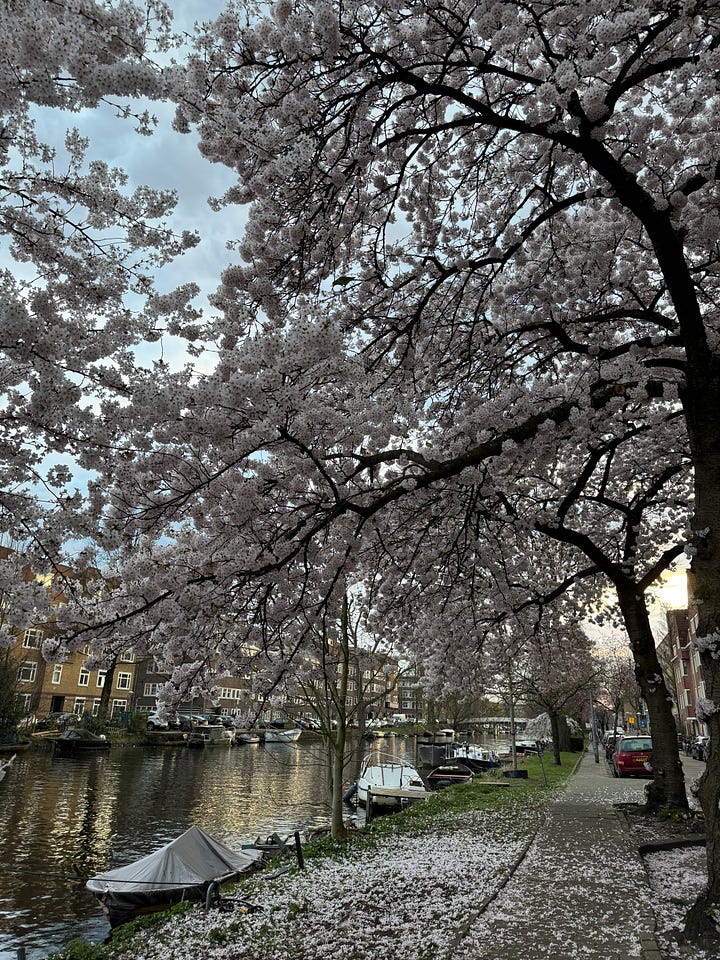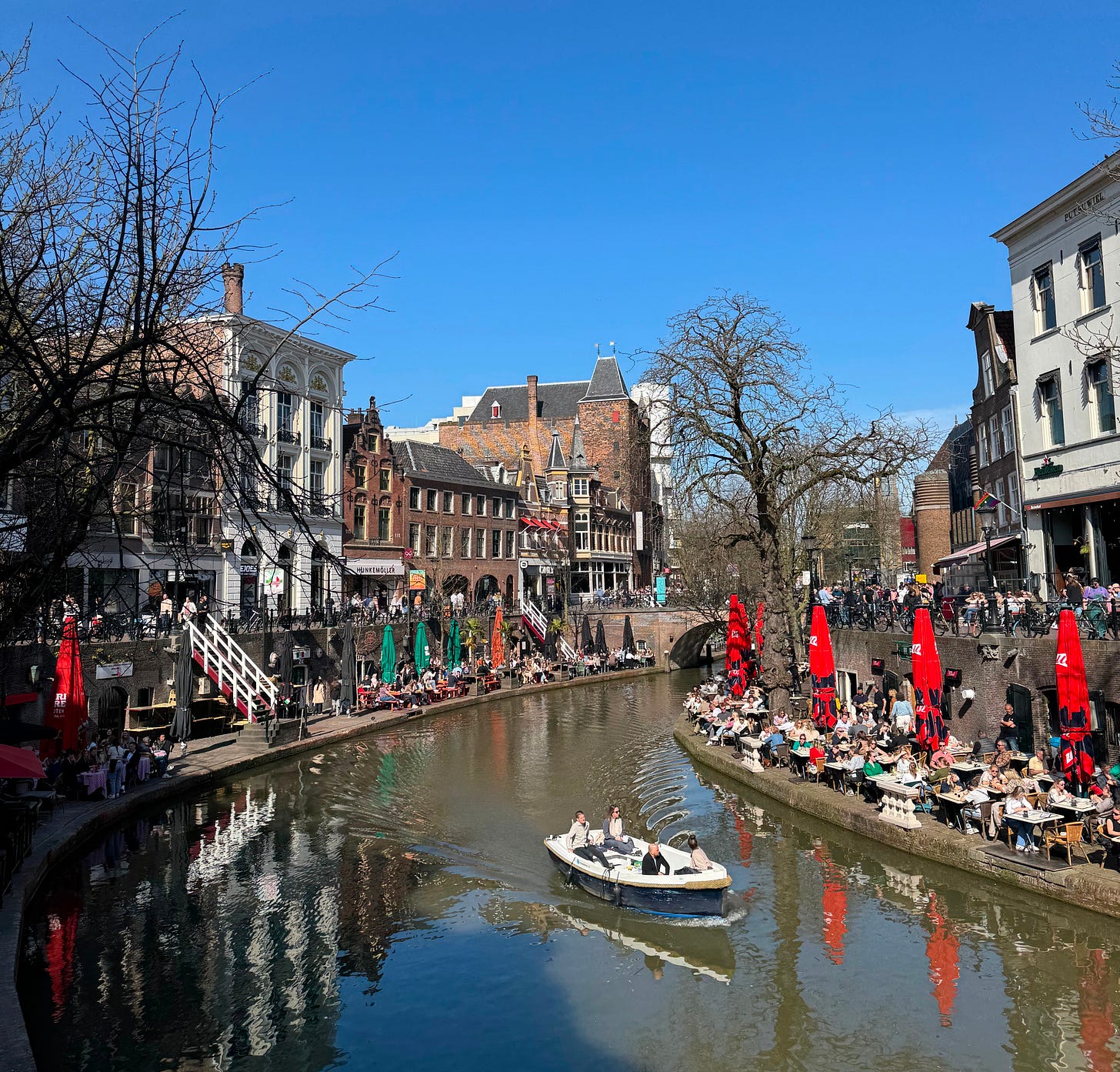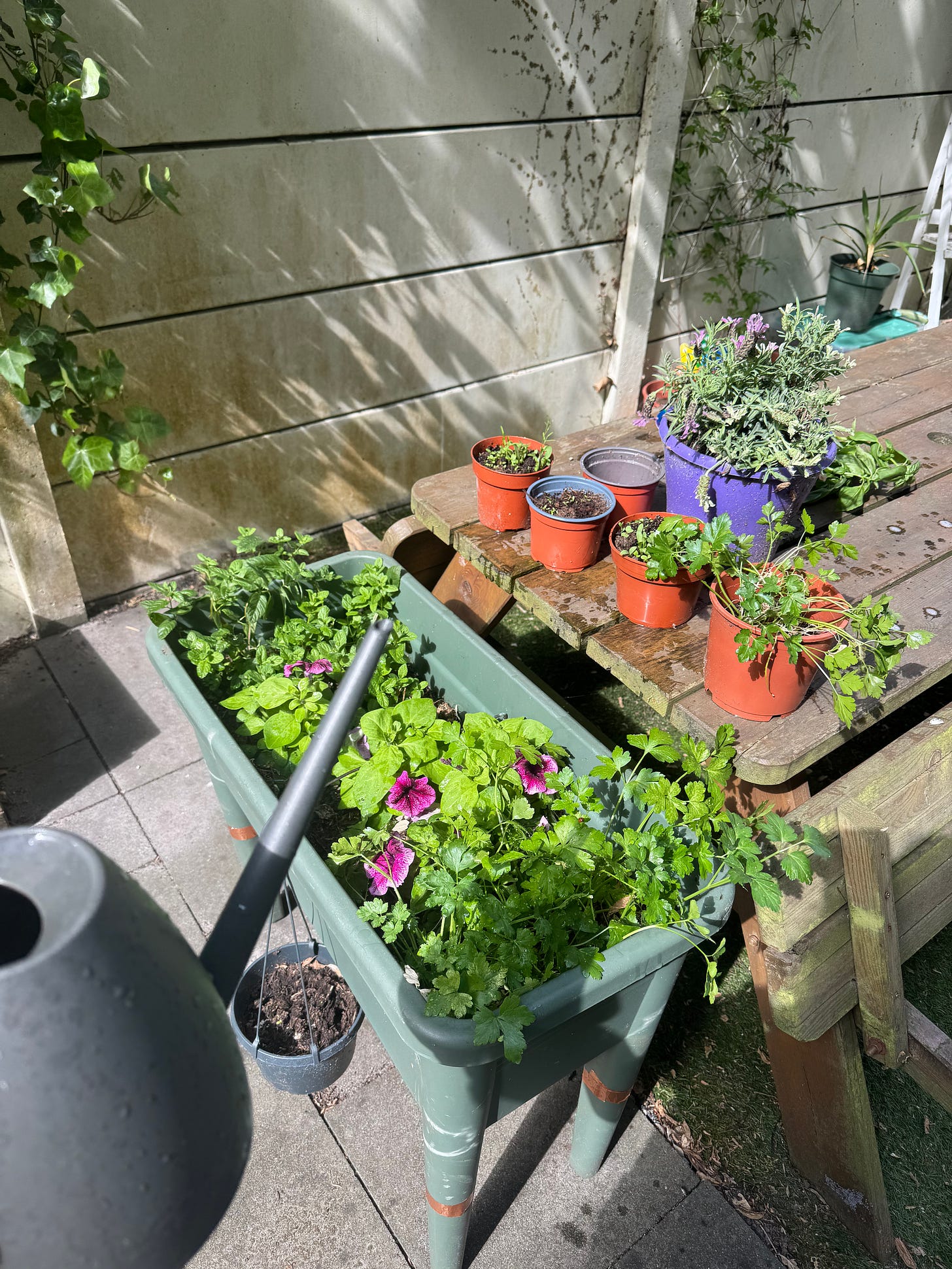Embracing the rollercoaster of spring.
As a new, casual gardener and someone who thinks a lot about the environment, I’ve started to view my tiny backyard and neighborhood differently this year.
Spring has sprung
We humans never seem to quite get a grasp on the fickle nature of spring weather. One afternoon we’re sitting in tank tops, playing hooky from work and basking in the fresh sun. When warm spring days begin in the Netherlands, the sidewalks and plazas explode with people sitting al fresco on terraces. The Dutch even turned this pastime into a verb “terrassen” - which means to sit on a terrace, with a cappuccino or, even better, a glass of white wine.
But then, the cold gray days return, seemingly out of nowhere. The city shivers and the citizens shuttle back indoors. People begrudgingly pull their warm jackets out of the back of the closet where, on a warmer day, they were convinced it could be stashed for the season. Of course, there is much moaning (loudly) about the rain and the wind.
But this year we have had a glut of blissfully warm days, and I found myself spending more time in my garden than past years. The hobby was heavily encouraged by an unseasonably hot spring, and it was an excuse to be outside all day. All this time in my garden has led to a newfound appreciation for this complicated season. I’ve noticed, for the first time, how new growth emerges after a springy cycle of sunny days and bursts of rain.
The season of blooms
I know it’s cliche; “April showers bring May flowers” after all, but this year I’ve actually noticed this botanical rhythm myself. On a rainy evening walk, I stopped to marvel at a bush of tiny white flowers practically glowing in the gloom. The bush seemed so happy! It was drowned in spring sun, grew like mad, and was now nourished by a healthy dose of spring rain.
This bush does not complain about rain, then sun, then rain, then sun. In fact, this bush has evolved over millions of years, to relish this fickle season. Within its tiny petals and woody branches is the innate knowledge that when the cold starts to lift and the days start to lengthen - its GROW, BABY, GROW. I stared at this bush and imagined within it an ecstatic dance of sugar transfer and carbon harvest and sucking up nitrogen and phosphorous, and all of a sudden, a big BLOOM.
I looked this up later, and it’s called “phenological synchrony”: the careful timing of growth and flowering in response to environmental cues. After absorbing photosynthetic energy during sunny periods, plants convert rainfall into explosive growth and use stored carbohydrates for flowering. Flowering plants have delicate molecular mechanisms that detect changes in day length and temperature patterns. When these sensors detect that critical spring thresholds have been reached, this triggers a cascade of activity. What looks like a simple bloom is actually a culmination of molecular-timed events, that can be sent out of whack by changes in the environment.
An unseasonably warm spring
I’ve also noticed (alongside my fellow countrymen who are flocking to terraces) that this year we’ve had what feels like a crazy warm spring. The Netherlands has had 400 hours of sunshine since March 1, where the average is 234 - a 65% increase. Rainfall is down and average temperatures are a full degree Celsius warmer than the norm. Over the past three decades, flowering times have shifted forward compared to the mid-20th century, arriving 3-22 days earlier. Ecologists call this "season creep," and it's disrupting ecological relationships. For example, if plants flower earlier, this may be a mismatch with pollinators who haven't yet adjusted to the changing spring - a phenomenon called "phenological mismatch.”

I dragged my shorts and dresses out from under my bed much earlier this year, and my garden is exploding, but I can’t enjoy the sun without a bit of a sinking feeling; I know that sea levels are rising - more so in the Netherlands than other parts of the world - and that abnormal weather can also mean heat waves, massive storms and flooding. All events that have taken lives in Europe in recent years.
Climate change lurks behind what may feel like “better” weather. Plants and ecosystems have evolved to adapt to climatic conditions of the Holocene period, but we are no longer living within that range. We’ve entered the anthropocene, a climatic period defined by human’s impact on greenhouse gas levels and thus global temperatures and climate. Looking at the famous temperature stripe picture, I’m already sweating imagining future spring heat.
Learning resilience from plants
Back in Amsterdam, I’ve had to water the plants in my house and garden a lot more this spring; they shrivel quickly without overcast days or spring showers. Slugs, who I usually battle, are noticeably absent, unable to procreate without standard humidity. This small behavior change (increased watering) is actually a micro-climate change adaptation strategy, easy enough to do, and allows my normal way of life to continue. But I know we must both adapt and mitigate if we are to survive and thrive. We must reduce our greenhouse gas emissions while confronting and preparing for the fact that things are going to change. I’m buoyed by research identifying innovations in agriculture to prepare for drier seasons, evidence of species developing resilience to climate change and commitments big and small by countries and individuals determined to take up the fight.
A invitation to observe your spring
I recently heard a podcast by the mindfulness teacher Tara Brach who casually said “bringing an engaged presence to the world is a medicine” and that really stuck. . This spring I’ve been observing more and been heartily rewarded. My year has been full of highs and lows and chock full of uncertainty, but one thing that is steadfast is that I find something amazing in nature every time I choose to look.
I’ve noticed how the bare canopy turns green once again, which seems to happen overnight. The naked canals, all of a sudden, trellised in thick leaves, growing to the beat of the season’s circadian rhythm. Every year I see people flock to the cherry blossoms on the canal near my house, but I wonder if they notice the gradual greening of the treetops or the glowing white bush?
I also invented a new micro-season which I’ve dubbed ‘confetti time’. If you live near one or more cherry-blossom trees, you can easily experience confetti time. All you have to do is give a flowering tree a gentle shake of a branch as you pass by. The first few days of blooming, you may have nothing to report (low confetti level). But give it a week or so, and a tug on a branch leads to a proper downpour of tiny petals. I recommend turning every walk into a tiny parade during confetti time.
I encourage you to pay a little more attention as you move through your world this spring, perhaps you can identify a micro-season. A little window when your favorite tree is all of a sudden covered with tiny leaves, looking like green peach fuzz, or when a spectacular rose bush is in full force. We don’t know how plants will respond to the ever-changing climate, so now is a good a time as ever to stop and smell those roses and embrace the rollercoaster of spring.










Love calling it confetti time!